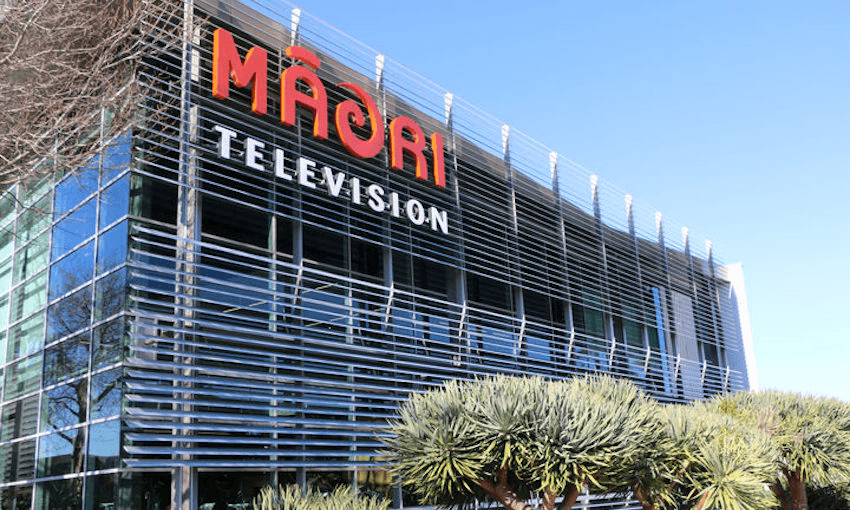The CEO of Pango Productions and creator of some of Māori Television’s biggest hits, Bailey Mackey, lays out his vision for the future of Māori media – and there’s no place for Māori Television in it.
I love Māori Television. I always have and always will. I started working there one week before it launched in 2004 as the inaugural head of sport. I remember the mix of apprehension and excitement as the decades of struggle to have te reo Māori recognised by a major broadcaster came to a head on that brisk morning in Newmarket. The pre-start up phase of Māori TV had been a mess, with misspending allegations at Aotearoa TV (the pilot precursor) and fraudulent CEO John Davy adding to the nervousness. After stints at TVNZ and TV3 many thought going to Māori TV was career suicide and I’m pretty sure (not that anyone would admit it) no one really knew what the hell was going to happen. Would we make it to air? Would we find an audience? Would we keep out of the papers? All valid concerns at the time.
What happened over the next three and a half years was the most crazy, intense but fulfilling ride of my career. I grew up at Māori TV and some of my fondest memories and dearest friends come from that period. We built a sports department that included the show CODE and we made innovative deals with the Breakers, NZ Rugby League, Waka Ama and David Tua, to name a few. We outmanoeuvred other networks and I learned a lot along the way, but mostly we had fun. I produced, directed and presented. We all did whatever needed to be done. We won awards and when we were in the papers it was positive. Most importantly, we found an audience and we were fundamentally contributing to the overall aim of revitalising and normalising te reo Māori.
In subsequent years I have continued to contribute to Māori TV as an independent producer and have produced some of their biggest shows, including ANZAC Day, Te Matatini, Beneath the Māori Moon, Sidewalk Karaoke and Piri’s Tiki Tour.
I would love to think that I have helped shape the channel in the same way it has shaped me, which is why it pains me to say this: it’s time for Māori Television to go.
Recently, the minister for Māori development Nanaia Mahuta set out some options in the Māori Media Sector Shift review document. The proposals included a Centre for Media Excellence including cadetships and mentoring for Māori and iwi media, to be located within Māori Television; a single Māori news service to be located within the Māori Television Service; a Reo Aotearoa national radio station to be delivered through the Māori Television Service; and “digital pataka” where digital content would be held within storehouses across the Māori, iwi and public media ecosystems.
The review doesn’t address the elephant in the room, which is why the government is continuing to prop up an outdated platform that is losing its audience.
The document itself shows (albeit using outdated data) that Māori TV is the 15th most used platform by Māori, out of 16.
Māori Television’s time as a linear television service needs to come to an end and something completely new be built in its place.
The idea that it be the home for a single news service or a centre of media excellence (when it has no track record of being a training provider and isn’t aligned with best practice) is bad and avoids the real issue of what is needed: an audience-focused publisher.
This new hub needs to become the digital portal for all people who have an interest in te reo Māori. It needs to be a fully-fledged digital OTT platform (a streaming media service offered directly to viewers) and it needs become one fast. The portal could include all Te Māngai Pāho funded content since its inception as well as be the home for an increased focus on high-end original programming. And it would need an increase in direct funding from what Māori Television is currently receiving.
Secondly, while it’s important to acknowledge Māori language revitalisation efforts as the primary driver of the sector, it is equally important to recognise the need for an appropriate articulation of a Māori perspective in English.
The discussion document places little importance on a Māori perspective in English. While I acknowledge that to some extent this occurs incidentally via content funded to “promote Māori language and Māori culture”, there needs to be greater provision for English language funded content without diluting the reo Māori-focused investment. A generous amount of contestable funding for platform-agnostic content in te reo Māori and English needs to be made available, and that content provided to a range of distributors, as well as the centralised streaming service.
Like many others, I will be putting forward a submission in response to the options presented by the minister. I agree with others such as my good friends Mihingarangi Forbes and Annabelle Lee-Mather in regards to ensuring a much wider spread of news and current affairs and the need for plurality as an important part of a democratic society.
Māori language-focused government investment has concentrated on language outcomes and therefore has undertaken most of the heavy lifting when it comes to providing a Māori worldview. It is important to acknowledge while a Māori worldview is gained through te reo Māori broadcasting, that from a funding perspective these outcomes are varied and responsibility sits with different government agencies and ministers.
My set of proposed recommendations are designed to create better cohesion by placing the responsibility for Māori language revitalisation and Māori perspective in English focused content under the one minister and just two agencies.
Māori Television was approached to write a response but declined.





